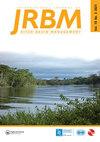明渠水流中顺行突发性植被的阻力系数
IF 1.9
Q3 WATER RESOURCES
International Journal of River Basin Management
Pub Date : 2021-09-06
DOI:10.1080/15715124.2021.1961796
引用次数: 7
摘要
摘要沿着河岸,树木和灌木通常种植在一条线上。就树木而言,树干在水力实验室中由一组圆柱体模拟,阻力系数可以使用各种不同的方法进行估计,包括直接测量、使用动量方程、将湍流强度和阻力等同起来、数值建模和遗传编程。然而,为了简单起见,科学文献中提出了许多方程,允许对其进行即时估计。本工作中使用了其中一些方程来验证其再现Mulahasan和Stoesser([2017])获得的直列圆柱体实验数据的能力。明渠水流中直列植被的流动阻力。国际流域管理杂志,15(3),329–334。https://doi.org/10.1080/15715124.2017.1307847),他通过应用动量方程获得了阻力。为此使用了几种统计描述符。我们发现,从交错和随机排列中导出的方程通常会大量高估CD值;相反,一些关系,特别是从平方排列中导出的关系,提供了更好的结果。本文章由计算机程序翻译,如有差异,请以英文原文为准。
Drag coefficient of in-line emergent vegetation in open channel flow
ABSTRACT Along the banks of rivers, trees and bushes are often planted in a single line. In the case of trees, the trunks are simulated in hydraulic laboratories by a set of cylinders, and the drag coefficient can be estimated with the use of various different methodologies, including by direct measurement, using the momentum equation, equating turbulence intensity and drag force, numerical modeling, and genetic programming. However, for the sake of simplicity, many equations have been proposed in the scientific literature that allows its immediate estimation. Some of these equations are used in this work to verify their ability to reproduce experimental data obtained for in-line cylinders by Mulahasan and Stoesser ([2017]. Flow resistance of in-line vegetation in open channel flow. International Journal of River Basin Management, 15(3), 329–334. https://doi.org/10.1080/15715124.2017.1307847), who obtained the drag force by applying the momentum equation. Several statistical descriptors have been used for this purpose. We found that the equations derived from staggered and random arrangements generally overestimate by a large amount the CD values; instead, a few relationships and in particular one derived from a squared arrangement provide much better results.
求助全文
通过发布文献求助,成功后即可免费获取论文全文。
去求助
来源期刊

International Journal of River Basin Management
WATER RESOURCES-
CiteScore
6.00
自引率
4.00%
发文量
48
期刊介绍:
include, but are not limited to new developments or applications in the following areas: AREAS OF INTEREST - integrated water resources management - watershed land use planning and management - spatial planning and management of floodplains - flood forecasting and flood risk management - drought forecasting and drought management - floodplain, river and estuarine restoration - climate change impact prediction and planning of remedial measures - management of mountain rivers - water quality management including non point source pollution - operation strategies for engineered river systems - maintenance strategies for river systems and for structures - project-affected-people and stakeholder participation - conservation of natural and cultural heritage
 求助内容:
求助内容: 应助结果提醒方式:
应助结果提醒方式:


